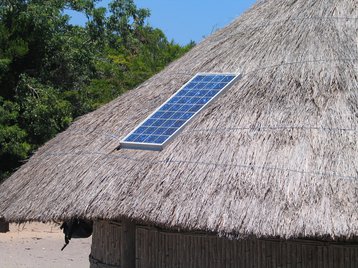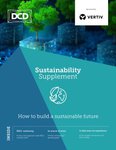If you are sourcing renewable energy for your data center, the accepted wisdom is that it is best to do it as locally as possible, so you are paying for renewable electricity that is generated on your grid, and (as near as possible) consumed at your site.
But there’s a new scheme that takes almost the exact opposite approach - paying for electricity which is generated on the other side of the world, and may even be completely off-grid.
RECs criticized
Renewable energy certificates (RECs) are an offset arrangement, intended to allow large users to support renewable energy generation, even if they can’t buy renewable energy locally.
Each REC represents 1MWh of renewable energy. If a user buys 1MWh of renewable energy, they also get the REC and “retire” it, putting it towards their claims to use renewable energy.
If the user can’t get renewable energy locally, they buy an “unbundled” REC. They pay their regular grid provider for the energy they actually used, and an additional fee to a renewable energy provider somewhere else.
“The REC was a natural instrument to use for accounting,” says Ricky Buch, CTO of Powertrust, a producer of advance REC schemes. “Because it had been established and proven in the utility compliance market, we saw an expansion of unbundled certificates, because companies wanted to make verifiable claims.”
However, unbundled RECs have been criticized by renewable energy analysts who say they are little more than greenwashing, allowing corporations to falsely inflate their green energy figures, while doing very little to promote actual green energy usage.
Their prices are very low compared to the underlying energy price: electricity in the US costs about $150/MWh (EIA). The price of unbundled RECs has been as low as $1 per MWh (US EPA), but has increased somewhat since then. This low price reflects their low value as a driver of decarbonization.
Buch takes the criticism of unbundled RECs on board: “A lot of the projects that are generating these RECs are 50 or 60 years old. The investors have already made the returns.”
Analyst David Mytton wants the industry to rely less on unbundled RECs: “Most data center sustainability strategies still focus on renewable energy certificates (RECs),” he said in a DCD article in 2021. “RECs are now considered to be low-quality products because they cannot credibly be used to back claims of 100 percent renewable energy use.
Mytton’s advice is as follows: “To avoid accusations of greenwashing, data center operators must consider investing in a portfolio of renewable energy products. RECs may play a part, but power purchase agreements (PPAs) are becoming more popular, even though there can be financial risks involved.”
These PPAs fund renewable power directly, by effectively paying for whole projects like solar farms and wind projects. The renewable power, and the REC associated with it, are bundled together.
“In the PPA they get the electricity and they get the REC,” says Buch. “You need the REC to actually make the claim.”
The most highly-regarded PPAs actually fund projects so close to the tech company that it is possible to envisage the actual energy going directly from the solar plant to the data center.
A REC for the world?
Despite the growing criticism of RECs, and the move to PPAs, a new approach has emerged which goes in the opposite direction, taking the much-criticized unbundled nature of RECs, and turning it into a virtue.
What if RECs could be created which were even more unbundled? So unbundled, in fact, that they could support renewable energy projects on the other side of the world?
RECs that did this could address a pressing world problem - the shortage of clean reliable power in developing communities.
More than 750 million people still lack basic electricity, according to The World Bank, and two billion more have unreliable electricity supplies, in areas such as Brazil, India, sub-Saharan Africa, and Southeast Asia.
Access to affordable clean energy for all is one of the UN's 17 development goals: the UN wants to see “access to affordable, reliable, sustainable and modern energy for all.”
While tech firms are funding large solar farms in the rich world, developing agencies are struggling to get funds for small projects that are desperately needed.
These might include solar microgrids in remote communities on the Amazon river in Brazil, or storage systems to enable solar panels to power demands in hospitals and schools.
There are many places where there is currently no electricity supply, or else electricity is derived from dirty sources such as diesel generators.
But providing clean energy is an uphill struggle because such electricity projects are hard to finance alongside immediate issues such as drought and famine.
Renewable energy projects in needy areas are usually on a small scale, and often off the grid, so it is hard to route funds to them, and many communities are forced to continue using polluting, climate-harming fossil fuels.
Enter the D-REC
Distributed RECs (D-RECs) are designed to aggregate the benefits of small renewable energy projects, and monetize them so that Western corporations can put in large amounts of investment, that will count towards their net-zero goals.
The idea was created around 2020 by Ricky Buch and colleagues at Powertrust, and project developer South Pole. Buch explains: “We had experience in the renewable energy space [in developing nations]. But it's very difficult to actually finance these projects. And we had also seen that there was phenomenal growth in renewable development that was driven by corporate voluntary procurement.”
But the development wasn’t going where it was most needed: ”These companies were establishing Net Zero targets, or 100 percent renewable energy targets. That led to massive growth and development. Last year, some 36GW of new capacity was contracted by corporates. But 90 to 95 percent of that is concentrated in the US and in Europe.”
He goes on: “We saw there was a massive need for investment in renewable energy, especially in emerging markets. But the mechanisms that corporates are using to increase capacity and really hadn't filtered down to those markets. The way the environmental markets are designed, they're really catering towards utility-scale projects.”
In many countries, PPAs simply can’t be done, says Buch: “In a lot of emerging markets, you cannot actually structure a bilateral agreement like that. It has to go through the utility. You can get a green tariff, but a PPA is not a very common instrument in emerging markets.”
Powertrust was set up to address the issue, but Buch and colleagues quickly realized they needed a bridge between the capital markets and projects in emerging markets, which tended to be smaller than those in the developed world: “We realized we couldn't just sell certificates, we needed to ensure that there were frameworks in place that corporates can use to reliably account for the certificates that they would purchase.”
The D-REC initiative worked with existing sustainability accounting standards, to extend them: “In particular, to allow for the participation of small scale projects, which up to this point has been quite challenging.”
The difficulty of aggregating and certifying multiple small-scale projects had more or less excluded emerging countries from corporate purchasing. D-RECs aim to solve this with a back-end which automates a distributed network of projects.
The idea was formally launched in December 2022 with the D-REC Initiative set up as a Swiss-based not-for-profit. The idea has been backed by organizations including the Shell Foundation, Microsoft, and the UK's Foreign, Commonwealth, and Development Office.
“You're still getting a REC that indicates power has been generated by a zero carbon source,” says Buch. “But you also have data to say that that particular distributed asset was powering a hospital or school, or was supporting other UN Sustainable Development Goals in addition to seven and 13, which are the energy-focused ones.”
Solar plants are an asset which can either be owned by the developer that built them, or by a holding company, which contracts with the customer, which might be a large hospital. The hospital buys its power from the owner of the asset, often with a PPA, Buch explains.
“So the hospital is paying for electricity. But on top of that, there is this additional revenue stream that comes from the REC, which is owned by whoever owns the asset,” he says. “We buy from whomever owns that REC.”
Because of the finance, the owner of the solar plant is able to offer electricity to the hospital for a lower price, he says. “The developer who may have charged X for that electricity is now charging X minus something, because of the additional revenue, which can make the project financially viable and allows them to offer a reduced rate to the hospital.”
Backed by blockchain
D-RECs are powered by a distributed ledger system, that works like a “central bank,” tracking the generation of energy in small-scale projects, and the incoming funds. It’s based on blockchain, says Buch, but relies on proof of authority, not proof of work, so it doesn’t suffer from the insatiable energy demands of cryptocurrencies like Bitcoin.
As with RECs, one unit of energy (1kWh in this case) qualifies for one D-REC. The D-REC scheme aggregates generated energy to issue D-RECs, and retires D-RECs when they are paid for by investors.
The scheme tracks generation data in near real-time, from potentially hundreds of thousands of sources. The data is aggregated and validated automatically.
“We worked closely with the Energy Web Foundation, which is a nonprofit that is focused on using distributed ledger technology for the energy space,” says Buch. “One of the applications that they have focused on is renewable energy.”
To deliver a traceable system, D-RECs are based on a distributed ledger system for acquiring, verifying and tracking renewable energy data from distributed assets.
Cryptocurrencies like Bitcoin use blockchain, but apply a “proof of work” validation mechanism, which wastes energy, says Buch: “Energy Web uses a proof of authority validation mechanism and so it is much less much less energy intensive than proof of work.”
“In this new market, the transaction goes like this: a DRE developer builds a small, renewable energy installation, like a mini-grid,” says a blog by EnAccess, a firm that helped develop the D-REC platform.
The mini-grid produces electricity. One MWh of this electricity is equal to one D-REC. This D-REC is then purchased by a corporation thousands of miles away from where the electricity is generated. Each D-REC is unique and can only be sold once, and then canceled.”
But what does the D-REC actually pay for? According to EnAccess, it is slightly different from the carbon market, which monetizes the value of emissions reductions: “The key difference is that D-RECs monetize the environmental attributes of the renewable energy produced rather than emissions avoided.”
According to EnAccess, D-RECs put a price tag on positive benefits from a project, including health benefits, and the economic boost for low-income families, alongside their carbon emission reductions: “The D-REC simply broadens the scope of this existing mechanism.”
As EnAccess says “This data could come from thousands, or potentially hundreds of thousands of sources. Data could be fed to the platform from sources like a mini-grid in Uganda or PV panels in India, and thousands of other small-scale installations around the globe. D-REC data is too difficult to be handled and verified manually, and will rely on automated data processing.”
EnAccess says the backend will be trusted because it is built on a proven open-source platform: “The D-REC initiative builds on data analysis origin module code for environmental attribute tracking, developed by the Energy Web Foundation.”
“Trust in the system that verifies the data and issues the certificates is absolutely vital,” says EnAccess: “Not only is the platform being built on existing, proven technology for measuring and verifying energy generation data, but the entire concept and governance of D-RECs will be built with open source principles too.”
First customer: Salesforce
The goal of the D-REC scheme is to “assist leading global corporations and climate investors by providing access to new renewable energy investment opportunities in emerging markets.”
So the proof of the idea will be if large corporations can be persuaded to buy D-RECs in large enough numbers to finance significant energy projects where they are needed.
A number of big corporations have been sponsoring and fostering the development of D-RECs, but the first to step up and pay money was Salesforce.
Salesforce plans to buy a total of 280GWh of D-RECs over eight years, making it the first to endorse the concept with actual money.
At this stage, Salesforce’s purchase is small compared to its total energy needs, and also to its purchase of renewable energy.
The company announced in 2022 that it was using 100 percent renewable energy - which means in 2022 alone, it bought 800GWh of renewable energy, through multiple PPAs and other instruments
Its D-REC purchase will only match a few percent of that: “It's 35GWh per year for eight years,” says Buch. “That roughly translates into something like, 25-35MW of new capacity.”
But Salesforce says this is a significant move to get renewable energy investment where it is most needed.
“Nearly 95 percent of corporate renewable energy purchases today take place in North America and Europe. We need to ensure the rest of the world isn’t left behind,” said Megan Lorenzen, who leads power sector decarbonization for Salesforce.
“Salesforce was instrumental in the development of this high-impact procurement approach,” said Nick Fedorkiw, CEO of Powertrust, the energy procurement service which negotiated Salesforce’s D-REC purchase.
“However, the impact of this commitment goes far beyond Salesforce’s purchase. Companies across the globe have an appetite for high-impact renewable energy purchases and can’t find the supply they need. Now, as proven by Salesforce, companies can open up new sources of supply while maximizing social impact.”
Real impact
As with standard, unbundled RECs, the real value of the D-REC will depend on its financing. Buch believes that there are several factors in the underpinnings of D-RECs which make them credible compared with some other RECs.
“There is a spectrum of quality in the certificate market, just as there is in the carbon space,” he says. “Globally in the REC market, you go from a few dollars per megawatt hour to over $100/MWh, or close to $200/MWh.”
Green energy experts will want to evidence that the D-RECs are solid enough to fund new renewable power, and part of that will be the price. “The key question is additionality, which is what makes PPAs more expensive vs unbundled RECs,” says Mytton.
If price is a good indicator, it’s a tough one to get hold of, because, as Buch points out D-RECs are a traded commodity like other kinds of REC, and have only just been launched. Salesforce’s announcement did not specify the price it paid for its D-RECs.
Pressed by DCD, Buch indicated that in some contracts the REC revenue stream can be as much as 10-15 percent of the total project revenue, which has a value-multiplier when you factor in the cachet of getting US currency upfront.
“The majority of the money is still coming in from charging the off-taker for electricity. But the costs are borne in US dollars, while the revenues are earned in local currency. A US-dollar denominated, stable revenue stream helps a lot, and that 10 percent could be worth more if there is a local currency devaluation for example.”
In other words, D-RECs are, as the beer adverts used to say, reassuringly expensive.
Buch also argues that the money is definitely creating additionality. Unlike the much-criticized unbundled RECs offered by US utilities, D-RECs are “forward” contracts. That means that money given for the D-REC is invested in a project which is then built.
“When a corporate engages with us, we essentially then turn around and use the REC contract to build new capacity,” he says. “So there is further decarbonization happening that wouldn't have otherwise. Because we're coming in with a new revenue stream for project developers, you're basically supporting projects that have not yet been built. And then you do have a much stronger claim around additionality.”
D-RECs provide the up-front capital needed for new projects, says Buch. And they provide it in the form that the projects need - US dollars: “The agreement with Salesforce is a multi-year contract at a fixed price denominated in US dollars. That is a guarantee that a developer can take to the financiers to actually get capital to build projects. And it is a stable revenue stream that's backed by a blue-chip company. That’s what these developers often need.”
With such a new approach, there are still many issues to assess on D-RECs.
Some people we spoke to were skeptical about the system behind the scheme, and whether it can provide enough auditing and accountability, with an essentially automated marketplace.
Abstracting and aggregating multiple projects in different countries might actually just mask corruption and poor delivery, so D-RECs will probably need to backed by physical inspections, analyst Andy Lawrence of Uptime Institute suggested: “They may need boots on the ground.”
D-RECs certainly present a novel approach and are attacking a real problem.
If there’s proof that they are creating additional clean power where it is needed, then they may be a way to reclaim RECs as more than just an easy way for large corporations to claim virtue, while doing little to make real change in the world.




